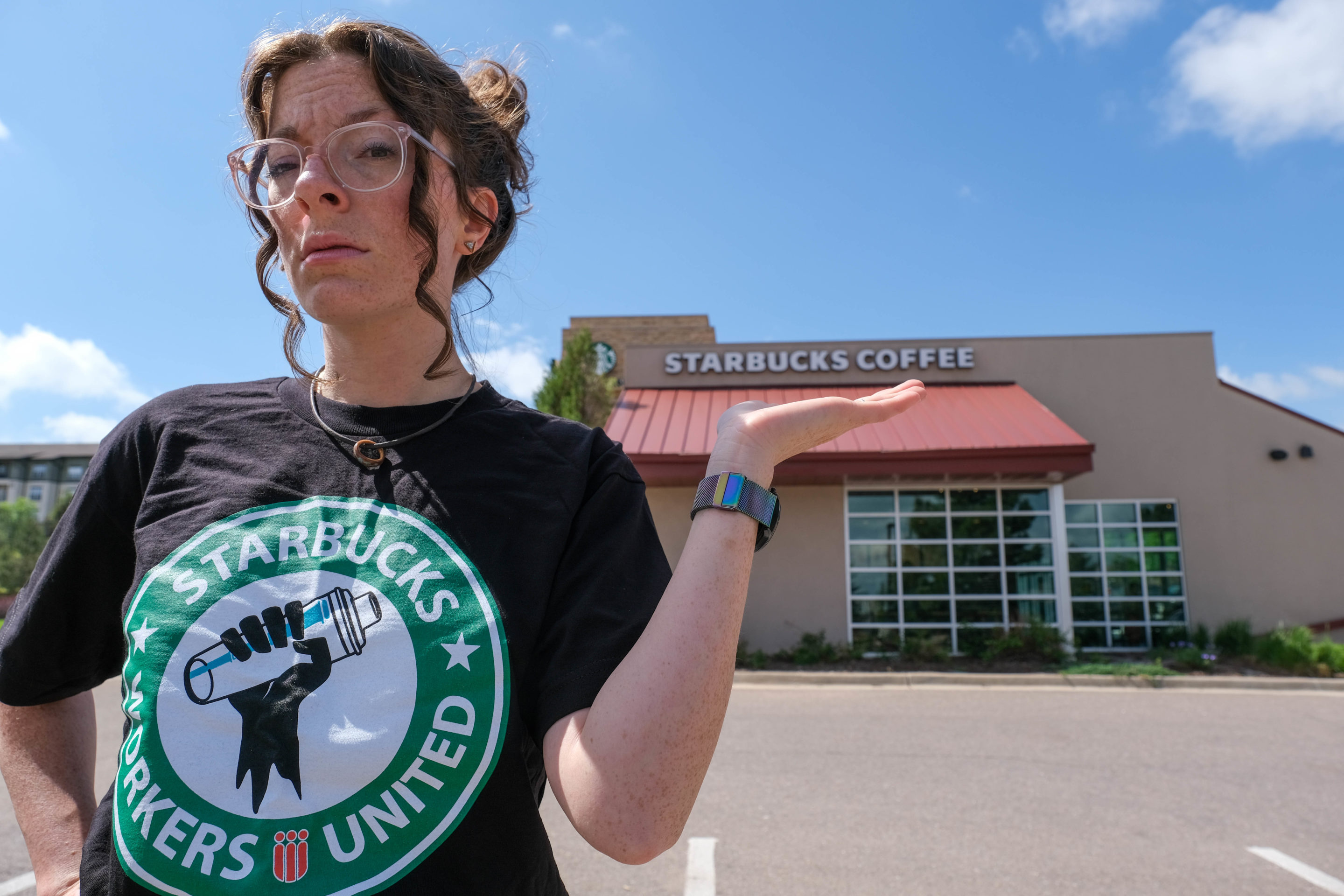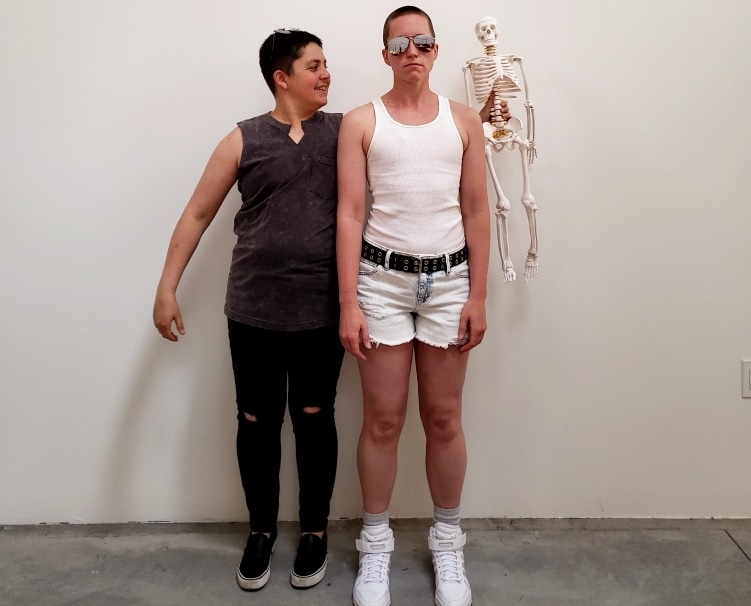//Denver’s last lesbian bar, Blush & Blu, prepares to celebrate Pride weekend in Denver on June 24. Photo by Madison Lauterbach | [email protected]
Blush & Blu is an almost forgettable link in the line of business fronts along East Colfax Avenue. If it wasn’t for the paint job echoing the transgender rights flag, it might disappear entirely. Inside, the humble storefront opens into a rainbow labyrinth with a bar, stage, pool table and underground lair akin to your parents’ basement, if your parents’ basement was lined with lesbian and queer literature, records, icons and canoodling couples.
John Roberts, aka Juiccy Misdemeanor, is a Black, queer drag performer and regular entertainer at Blush & Blu. Roberts has seen owner Jody Bouffard work to ensure that the outside world sees the bar the way she does—welcoming everyone across the LGBTQ+ spectrum.
“It was really awesome that they allowed space for queer and BIPOC entertainers to just be,” Roberts said. “It was a big thing to see visually as well as in the community that everyone was welcomed there. It’s not just a lesbian bar, it’s not just for white people. It’s a bar for inclusivity and a bar for everyone.”
Blush & Blu is the last remaining lesbian bar in Denver and one of only 21 in the country. While in this precarious position, it sits at the intersection of two debates embroiling the queer community: racial and broad-spectrum queer inclusion. As Blush & Blu celebrates Pride month with a Juneteenth dance party, grad shows and pride prom, questions linger regarding how the bar should fit into the queer ecosystem of Denver.
The gap between pride and Black pride
When out of drag, Roberts is a dancer with the Cleo Parker Robinson Dance company and uses both he/him and they/them pronouns. While in drag, Juiccy Misdemeanor uses both she/her and they/them pronouns. When they hear a microaggression, they speak up. According to them, Bouffard listens.
“As far as myself personally, me and Jody are really close,” Roberts said. “If I saw anything, I would say something and it would be rectified right away.”
However, Roberts’ sentiments aren’t universal. In a lawsuit filed in November 2021, three former employees—Jordan Feltner, Jessica Savage and Mary Hannah Williams—allege that Blush & Blu “has not always been a safe space for its workers.”
“In fact, Jody Bouffard, individually … willfully weaponized the so-called ‘safe space’ and the ‘family’ at Blush & Blu to create a culture of obligation where workers were required to accept mistreatment and brazen underpayment as a ‘service’ to the bar and broader queer community,” the lawsuit claims.
The lawsuit asserts that, in addition to allegedly misallocating tip money, Bouffard purportedly made bigoted comments against queer and transgender staff. While the suit remains unsettled, some members of Denver’s queer community stand by the plaintiffs.
Becky Taha’Blu is a Black, queer, femme, sex worker and co-founder of The Chrysalis House, a sex-positive collective. She performs burlesque in Denver including an early stint at Blush & Blu where she saw similar microaggressions as those alleged in the lawsuit.
“I don’t think [Bouffard] knew what they were doing,” Taha’Blu said. “It’s a defense mechanism that I’m sure they’ve crafted from being in white cis[gender] male spaces and then take back with them. White people move through the world as if they own it, no matter if you’re queer.”
Taha’Blu still believes there is a need for spaces run by and for queer femmes. She sees more public spaces for queer men, with lesbians historically being marginalized within the queer community; she knows why white queer women “play to the hierarchy.” But for her, the math doesn’t add up.
“If the cost of having a lesbian bar is marginalizing certain groups, then it’s not worth the cost—It’s basic math. If you’re not constantly growing, glowing and learning, then you’re stagnant. The bar is slightly stagnant. What was progressive is not progressive anymore.”
Bouffard declined to speak to Ms. Mayhem for this article. However, the bar owner did mention that she is countersuing the plaintiffs. Bouffard filed a counterclaim in January of this year on three counts: civil theft, conspiracy to commit civil theft and defamation. The countersuit claims, “While Savage, Williams, and Feltner paint their claims against Bouffard and Blush & Blu as arising from ‘mistreatment and underpayment of queer and transgender workers,’ indeed it was Savage and Williams who were stealing and conspiring to steal from Blush & Blu, and Feltner who has launched a campaign of public, inaccurate hate-fueled defamation attacks against the character of Bouffard and the reputation of Blush & Blu—a place that always welcomed them and treated them like family.”
Is Blush & Blu the end of the Denver lesbian bar line?
Questioning the role of lesbian bars extends beyond racial inclusivity into the realm of LGBTQ+ acceptance. Since their zenith of 200 in 1980, the fall of lesbian bars has been steady as prejudice has waned.
In 2020, Director Erica Rose released the short documentary “The Lesbian Bar Project” with two goals in mind: to financially support the remaining bars through the pandemic and to remember the ones already lost to time. With this time capsule, she showed an evolution from lesbian exclusivity to “lesbian-owned queer bars” embracing all members of the rainbow community.
“All of our bars that are on our list use both lesbian and queer,” Rose said. “I think that no one will just use ‘a lesbian bar.’ I think that it’s great because it’s inclusive of all aspects of the lesbian community.”
When some see the word lesbian and think of only cis women loving cis women, Rose sees more. She sees these bars as a space to shirk rigidity and expand the term to include those identifying as trans and nonbinary; a way to rid the community of transphobia, misogyny and hatred.
“The amount of space our community has reflects our social and political power. So when we only have 21 [bars] left in the country, it says something,” Rose said. “It says something about how much our country values queer women and people of marginalized genders.”
Rose believes these bars provide a unique space within the queer community, but others ask whether the increased inclusion of all gender expressions points to their inescapable extinction. Her project helped raised a new question: Is the loss of lesbian bars a true loss? Historian Lillian Faderman argues that their obsolescence is a sign of progress.
Faderman, often referred to as “The Mother of Lesbian History,” came out in a “gay girl bar” in the 1950s. At the time, heteronormativity constrained the community through the strict delineation of butch and femme.
“It was on 8th and Vermont in Los Angeles called The Open Door,” Faderman said. “I walked in and … it was like an epiphany. It all came clear: ‘Yes, this is what I wanted to do; this is who I wanted to be.’”
She’s seen a drastic change in the community as reflected in semantics and the spaces people inhabit. From butch and fluff, to lesbian, to LGBTQ+, she’s seen walls brought down, a change reflected in the role of bars.
“Bars began to disappear for interesting reasons and I know that many women are mourning those bars now,” Faderman said. “They no longer have to exist because that is no longer the only place you can go to be whatever you are: raunchy or butch or whatever you want to do with gender.”
Faderman believes that ultimately people vote with their feet. Blots on a bar’s reputation, like a lawsuit or implications that only lesbians are welcome, could be the last straw. When asked if Blush & Blu should continue the legacy of lesbian bars, Roberts hesitates.
“The word lesbian can categorize and shut off some of our community,” they said. “Everyone needs to feel at home, but it could cut off the branching and building of community in the intersectionality and the engagement of everyone, so I don’t know. It’s hard for me because I don’t want to take away something that someone may need but I also know that gay-presenting males have more open spaces.”
The future of truly free love
In June 2021, Juiccy Misdemeanor performed at Blush & Blu’s first Majestic Melanated Cabaret in celebration of Black pride. The bar has instituted monthly community discussions covering “hidden injustices in the queer community” with topics such as trans rights and Black, queer history.
“People think they’re a lesbian bar but they’re actually a queer bar that attracts the lesbian community,” Roberts said. “I sometimes feel that the queer aspect has been left alone which in turn can have these moments of injustice: ‘It’s a racist place;’ ‘It’s a this;’ ‘It’s a lesbian bar.’ Then you have to fight to say you’re a queer space.”
Although it is still listed as one of the remaining 21 lesbian bars and much of the staff are lesbians, others are transgender and nonbinary. Performers include cisgender men in drag. Many patrons are straight couples avoiding the “meat market” intensity of straight bars. But no matter the fate of Blush & Blu, the debates of inclusivity and intersectionality within queer spaces will continue.
“We know that these conversations can be many things: triggering, traumatic, awkward,” Roberts said. “But I think when you initiate something in a space where it’s not common, that’s a very big step. So I think the movement is there but it needs to be a little more active. Actions speak louder than words. You can say, ‘We do. We stand. We fight,’ but not doing, not standing, not fighting doesn’t work for me. Slowly but surely, they’re fighting.”
Enjoyed this story? Help us keep the lights on! Supporting local press ensures the stories you want to read keep coming, become a member for free today! Click here.





0 Comments